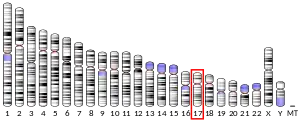| RNF213 | |||||||||||||||||||||||||||||||||||||||||||||||||||
|---|---|---|---|---|---|---|---|---|---|---|---|---|---|---|---|---|---|---|---|---|---|---|---|---|---|---|---|---|---|---|---|---|---|---|---|---|---|---|---|---|---|---|---|---|---|---|---|---|---|---|---|
| Identifiers | |||||||||||||||||||||||||||||||||||||||||||||||||||
| Aliases | RNF213, ALO17, C17orf27, KIAA1618, MYMY2, MYSTR, NET57, ring finger protein 213 | ||||||||||||||||||||||||||||||||||||||||||||||||||
| External IDs | OMIM: 613768 MGI: 1289196 HomoloGene: 45439 GeneCards: RNF213 | ||||||||||||||||||||||||||||||||||||||||||||||||||
| |||||||||||||||||||||||||||||||||||||||||||||||||||
| |||||||||||||||||||||||||||||||||||||||||||||||||||
| |||||||||||||||||||||||||||||||||||||||||||||||||||
| |||||||||||||||||||||||||||||||||||||||||||||||||||
| |||||||||||||||||||||||||||||||||||||||||||||||||||
| Wikidata | |||||||||||||||||||||||||||||||||||||||||||||||||||
| |||||||||||||||||||||||||||||||||||||||||||||||||||
Ring finger protein 213 is a protein that in humans is encoded by the RNF213 gene.[5] RNF213 is a 591kDa cytosolic E3 ubiquitin ligase with RING finger and AAA+ ATPase domains.
Clinical relevance
Chromosome-wide linkage analysis found that moyamoya disease locus resides in chromosome 17q25.[6] Genome-wide linkage analysis of 15 Japanese families of autosomal dominant moyamoya disease narrowed down the locus to 17q25.3.[7] Direct sequencing of the region and whole-exome sequencing identified the p.Arg4810Lys mutation in RNF213 gene as a founder mutation of moyamoya disease.[8] A genome-wide association study also identified RNF213 as a disease causing gene for Moyamoya disease.[9] Comparative evolutionary genome sequencing analyses in humans and monkeys showed that the strongest evidence for acceleration along the branch leading to hominines was RNF213.[10] RNF213 has been shown to be associated with blood flow and oxygen consumption.[11][12][13] Given that oxygen and glucose consumption scales with total neuron number, RNF213 may have played a role in facilitating the evolution of larger brains in primates.[10]
References
- 1 2 3 GRCh38: Ensembl release 89: ENSG00000173821 - Ensembl, May 2017
- 1 2 3 GRCm38: Ensembl release 89: ENSMUSG00000070327 - Ensembl, May 2017
- ↑ "Human PubMed Reference:". National Center for Biotechnology Information, U.S. National Library of Medicine.
- ↑ "Mouse PubMed Reference:". National Center for Biotechnology Information, U.S. National Library of Medicine.
- ↑ "Entrez Gene: ring finger protein 213".
- ↑ Yamauchi T, Tada M, Houkin K, Tanaka T, Nakamura Y, Kuroda S, et al. (April 2000). "Linkage of familial moyamoya disease (spontaneous occlusion of the circle of Willis) to chromosome 17q25". Stroke. 31 (4): 930–5. doi:10.1161/01.str.31.4.930. PMID 10754001.
- ↑ Mineharu Y, Liu W, Inoue K, Matsuura N, Inoue S, Takenaka K, et al. (June 2008). "Autosomal dominant moyamoya disease maps to chromosome 17q25.3". Neurology. 70 (24 Pt 2): 2357–63. doi:10.1212/01.wnl.0000291012.49986.f9. hdl:2433/135797. PMID 18463369. S2CID 1766812.
- ↑ Liu W, Morito D, Takashima S, Mineharu Y, Kobayashi H, Hitomi T, et al. (Jul 2011). "Identification of RNF213 as a susceptibility gene for moyamoya disease and its possible role in vascular development". PLOS ONE. 6 (7): e22542. Bibcode:2011PLoSO...622542L. doi:10.1371/journal.pone.0022542. PMC 3140517. PMID 21799892.
- ↑ Kamada F, Aoki Y, Narisawa A, Abe Y, Komatsuzaki S, Kikuchi A, et al. (January 2011). "A genome-wide association study identifies RNF213 as the first Moyamoya disease gene". Journal of Human Genetics. 56 (1): 34–40. doi:10.1038/jhg.2010.132. PMID 21048783.
- 1 2 Scally A, Dutheil JY, Hillier LW, Jordan GE, Goodhead I, Herrero J, et al. (March 2012). "Insights into hominid evolution from the gorilla genome sequence". Nature. 483 (7388): 169–75. Bibcode:2012Natur.483..169S. doi:10.1038/nature10842. PMC 3303130. PMID 22398555.
- ↑ Banh RS, Iorio C, Marcotte R, Xu Y, Cojocari D, Rahman AA, et al. (July 2016). "PTP1B controls non-mitochondrial oxygen consumption by regulating RNF213 to promote tumour survival during hypoxia". Nature Cell Biology. 18 (7): 803–813. doi:10.1038/ncb3376. PMC 4936519. PMID 27323329.
- ↑ Kobayashi H, Kabata R, Kinoshita H, Morimoto T, Ono K, Takeda M, et al. (May 2018). "Rare variants in RNF213, a susceptibility gene for moyamoya disease, are found in patients with pulmonary hypertension and aggravate hypoxia-induced pulmonary hypertension in mice". Pulmonary Circulation. 8 (3): 2045894018778155. doi:10.1177/2045894018778155. PMC 5991195. PMID 29718794.
- ↑ Morimoto T, Enmi JI, Hattori Y, Iguchi S, Saito S, Harada KH, et al. (February 2018). "Dysregulation of RNF213 promotes cerebral hypoperfusion". Scientific Reports. 8 (1): 3607. Bibcode:2018NatSR...8.3607M. doi:10.1038/s41598-018-22064-8. PMC 5827518. PMID 29483617.
Further reading
- Choudhary C, Kumar C, Gnad F, Nielsen ML, Rehman M, Walther TC, et al. (August 2009). "Lysine acetylation targets protein complexes and co-regulates major cellular functions". Science. 325 (5942): 834–40. Bibcode:2009Sci...325..834C. doi:10.1126/science.1175371. PMID 19608861. S2CID 206520776.
- Gautier VW, Gu L, O'Donoghue N, Pennington S, Sheehy N, Hall WW (May 2009). "In vitro nuclear interactome of the HIV-1 Tat protein". Retrovirology. 6: 47. doi:10.1186/1742-4690-6-47. PMC 2702331. PMID 19454010.
- Cools J, Wlodarska I, Somers R, Mentens N, Pedeutour F, Maes B, et al. (August 2002). "Identification of novel fusion partners of ALK, the anaplastic lymphoma kinase, in anaplastic large-cell lymphoma and inflammatory myofibroblastic tumor". Genes, Chromosomes & Cancer. 34 (4): 354–62. doi:10.1002/gcc.10033. PMID 12112524. S2CID 22808049.
- Imami K, Sugiyama N, Kyono Y, Tomita M, Ishihama Y (January 2008). "Automated phosphoproteome analysis for cultured cancer cells by two-dimensional nanoLC-MS using a calcined titania/C18 biphasic column". Analytical Sciences. 24 (1): 161–6. doi:10.2116/analsci.24.161. PMID 18187866.
- Dephoure N, Zhou C, Villén J, Beausoleil SA, Bakalarski CE, Elledge SJ, Gygi SP (August 2008). "A quantitative atlas of mitotic phosphorylation". Proceedings of the National Academy of Sciences of the United States of America. 105 (31): 10762–7. Bibcode:2008PNAS..10510762D. doi:10.1073/pnas.0805139105. PMC 2504835. PMID 18669648.
- Dias Neto E, Correa RG, Verjovski-Almeida S, Briones MR, Nagai MA, da Silva W, et al. (March 2000). "Shotgun sequencing of the human transcriptome with ORF expressed sequence tags". Proceedings of the National Academy of Sciences of the United States of America. 97 (7): 3491–6. Bibcode:2000PNAS...97.3491D. doi:10.1073/pnas.97.7.3491. PMC 16267. PMID 10737800.
- Han G, Ye M, Zhou H, Jiang X, Feng S, Jiang X, et al. (April 2008). "Large-scale phosphoproteome analysis of human liver tissue by enrichment and fractionation of phosphopeptides with strong anion exchange chromatography". Proteomics. 8 (7): 1346–61. doi:10.1002/pmic.200700884. PMID 18318008.



